IKEA: Innovation, Entrepreneurial Vision, and Competitive Strategies
VerifiedAdded on 2022/12/09
|12
|3915
|448
Report
AI Summary
This report provides an in-depth analysis of IKEA's strategy, enterprise, and innovation, examining the key drivers that contribute to its success. It explores IKEA's cost-cutting strategies, unique self-assembly furniture, use of recycled materials, and effective communication with employees and customers. The report also delves into IKEA's organizational structure, marketing strategies, and global operations, highlighting its presence in over 50 countries and its use of digital marketing, augmented reality, and social media. Furthermore, the report employs SWOT and Porter's Five Forces analyses to evaluate IKEA's competitive position and PESTLE analysis to assess the macro-environmental factors impacting its performance. Finally, the report touches upon the blue ocean strategy, emphasizing IKEA's ability to create a market where competition is minimized, fostering new demand and customer loyalty. The analysis provides a comprehensive understanding of IKEA's strategic approach to achieving and maintaining its market leadership.
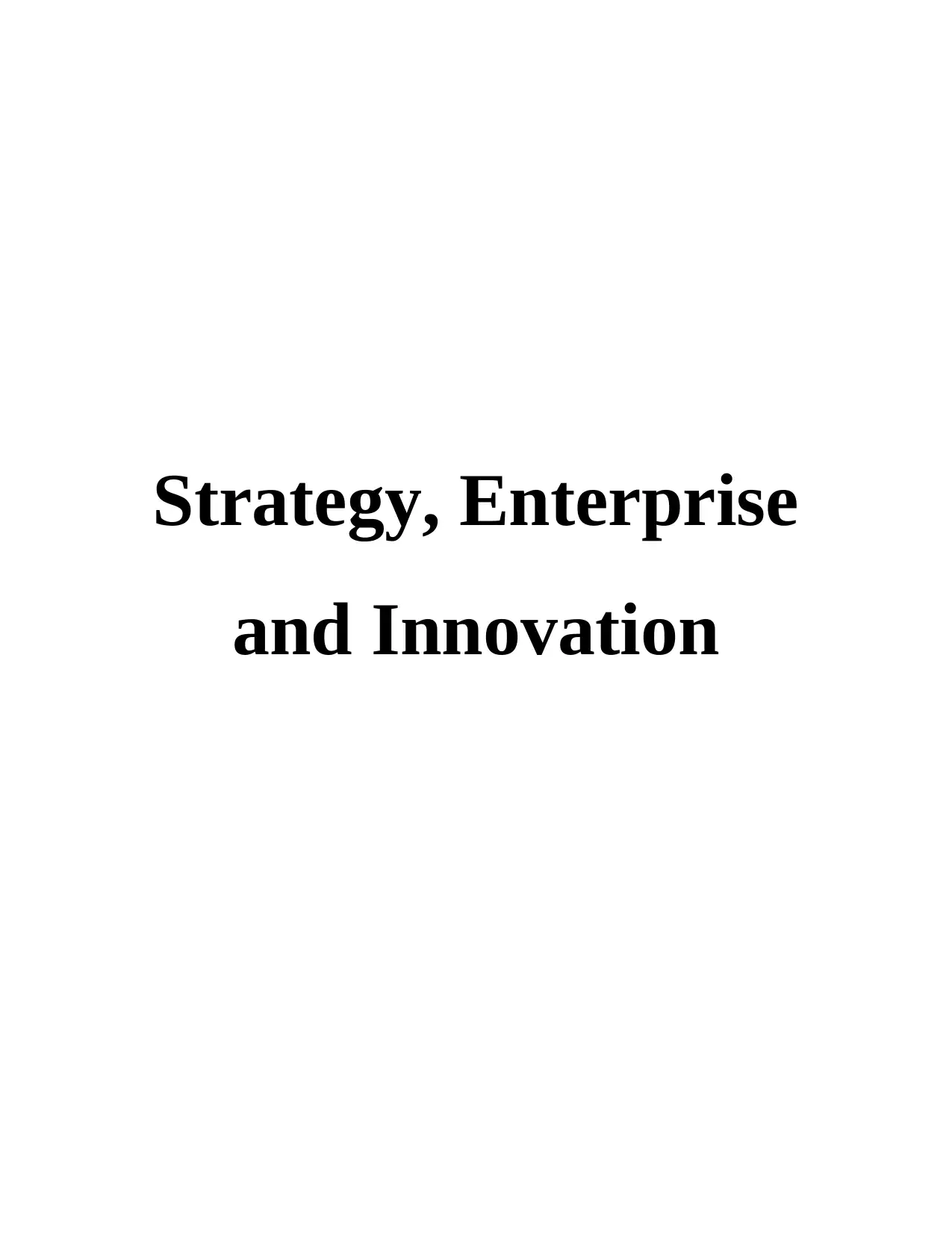
Strategy, Enterprise
and Innovation
and Innovation
Paraphrase This Document
Need a fresh take? Get an instant paraphrase of this document with our AI Paraphraser
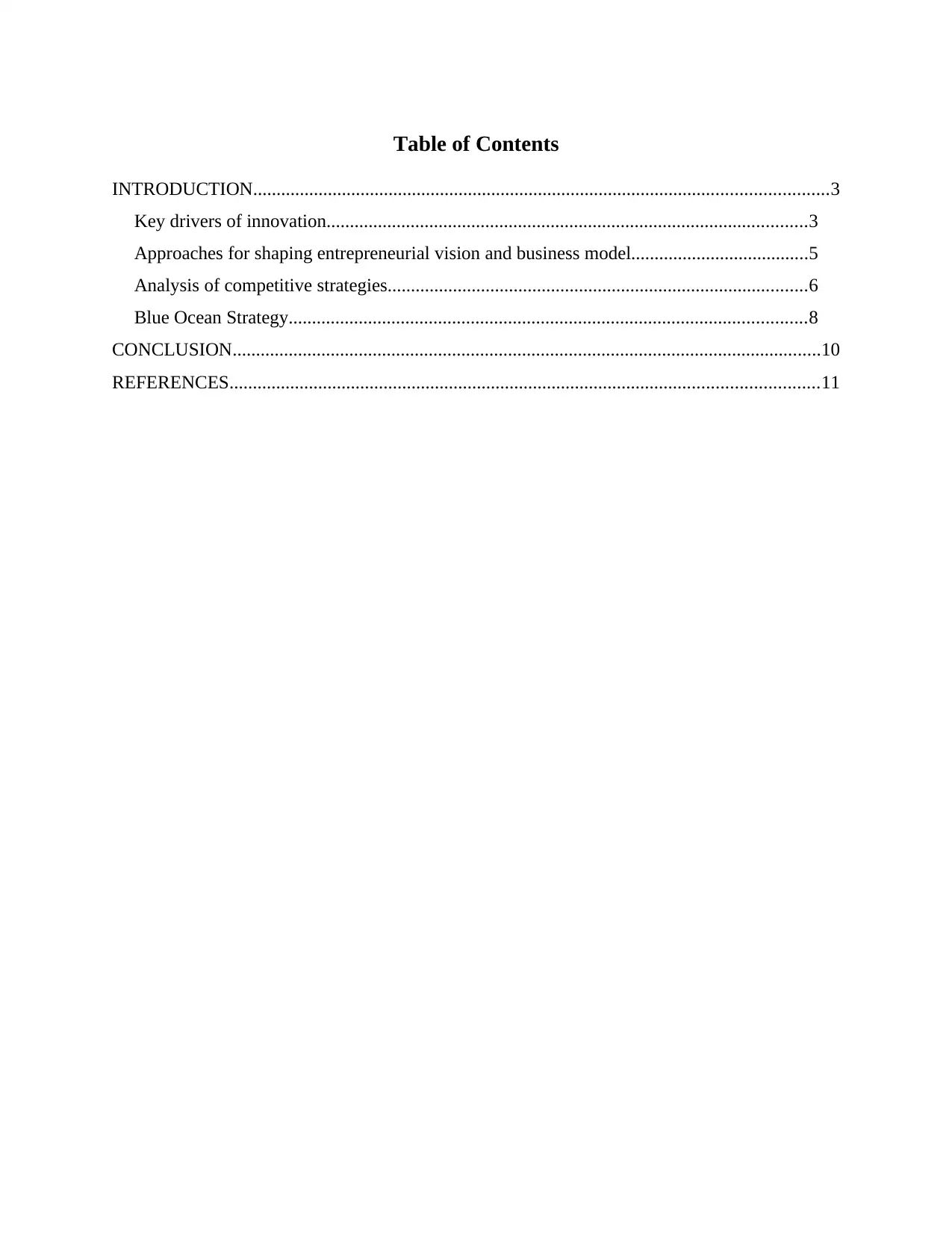
Table of Contents
INTRODUCTION...........................................................................................................................3
Key drivers of innovation.......................................................................................................3
Approaches for shaping entrepreneurial vision and business model......................................5
Analysis of competitive strategies..........................................................................................6
Blue Ocean Strategy...............................................................................................................8
CONCLUSION..............................................................................................................................10
REFERENCES..............................................................................................................................11
INTRODUCTION...........................................................................................................................3
Key drivers of innovation.......................................................................................................3
Approaches for shaping entrepreneurial vision and business model......................................5
Analysis of competitive strategies..........................................................................................6
Blue Ocean Strategy...............................................................................................................8
CONCLUSION..............................................................................................................................10
REFERENCES..............................................................................................................................11
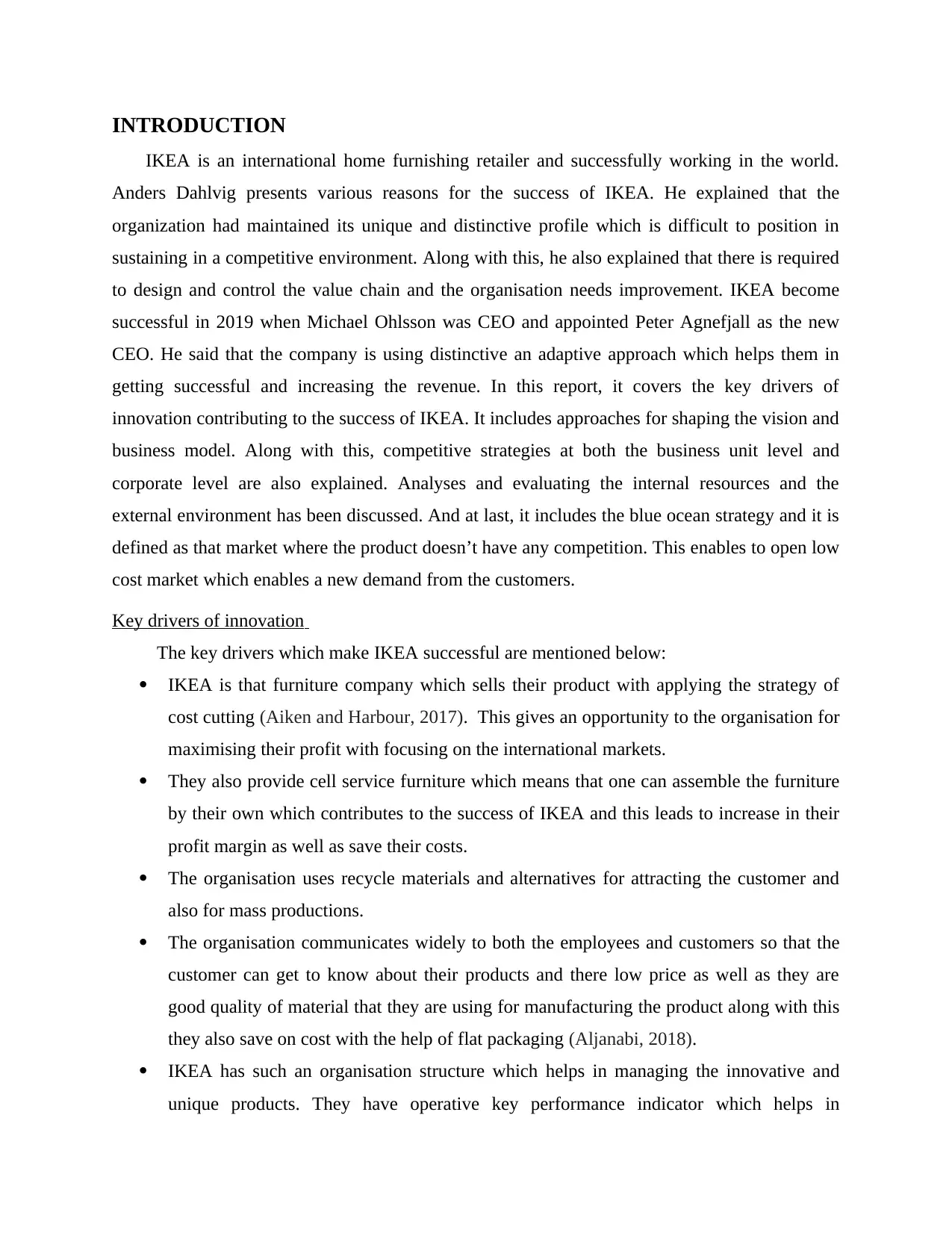
INTRODUCTION
IKEA is an international home furnishing retailer and successfully working in the world.
Anders Dahlvig presents various reasons for the success of IKEA. He explained that the
organization had maintained its unique and distinctive profile which is difficult to position in
sustaining in a competitive environment. Along with this, he also explained that there is required
to design and control the value chain and the organisation needs improvement. IKEA become
successful in 2019 when Michael Ohlsson was CEO and appointed Peter Agnefjall as the new
CEO. He said that the company is using distinctive an adaptive approach which helps them in
getting successful and increasing the revenue. In this report, it covers the key drivers of
innovation contributing to the success of IKEA. It includes approaches for shaping the vision and
business model. Along with this, competitive strategies at both the business unit level and
corporate level are also explained. Analyses and evaluating the internal resources and the
external environment has been discussed. And at last, it includes the blue ocean strategy and it is
defined as that market where the product doesn’t have any competition. This enables to open low
cost market which enables a new demand from the customers.
Key drivers of innovation
The key drivers which make IKEA successful are mentioned below:
IKEA is that furniture company which sells their product with applying the strategy of
cost cutting (Aiken and Harbour, 2017). This gives an opportunity to the organisation for
maximising their profit with focusing on the international markets.
They also provide cell service furniture which means that one can assemble the furniture
by their own which contributes to the success of IKEA and this leads to increase in their
profit margin as well as save their costs.
The organisation uses recycle materials and alternatives for attracting the customer and
also for mass productions.
The organisation communicates widely to both the employees and customers so that the
customer can get to know about their products and there low price as well as they are
good quality of material that they are using for manufacturing the product along with this
they also save on cost with the help of flat packaging (Aljanabi, 2018).
IKEA has such an organisation structure which helps in managing the innovative and
unique products. They have operative key performance indicator which helps in
IKEA is an international home furnishing retailer and successfully working in the world.
Anders Dahlvig presents various reasons for the success of IKEA. He explained that the
organization had maintained its unique and distinctive profile which is difficult to position in
sustaining in a competitive environment. Along with this, he also explained that there is required
to design and control the value chain and the organisation needs improvement. IKEA become
successful in 2019 when Michael Ohlsson was CEO and appointed Peter Agnefjall as the new
CEO. He said that the company is using distinctive an adaptive approach which helps them in
getting successful and increasing the revenue. In this report, it covers the key drivers of
innovation contributing to the success of IKEA. It includes approaches for shaping the vision and
business model. Along with this, competitive strategies at both the business unit level and
corporate level are also explained. Analyses and evaluating the internal resources and the
external environment has been discussed. And at last, it includes the blue ocean strategy and it is
defined as that market where the product doesn’t have any competition. This enables to open low
cost market which enables a new demand from the customers.
Key drivers of innovation
The key drivers which make IKEA successful are mentioned below:
IKEA is that furniture company which sells their product with applying the strategy of
cost cutting (Aiken and Harbour, 2017). This gives an opportunity to the organisation for
maximising their profit with focusing on the international markets.
They also provide cell service furniture which means that one can assemble the furniture
by their own which contributes to the success of IKEA and this leads to increase in their
profit margin as well as save their costs.
The organisation uses recycle materials and alternatives for attracting the customer and
also for mass productions.
The organisation communicates widely to both the employees and customers so that the
customer can get to know about their products and there low price as well as they are
good quality of material that they are using for manufacturing the product along with this
they also save on cost with the help of flat packaging (Aljanabi, 2018).
IKEA has such an organisation structure which helps in managing the innovative and
unique products. They have operative key performance indicator which helps in
⊘ This is a preview!⊘
Do you want full access?
Subscribe today to unlock all pages.

Trusted by 1+ million students worldwide
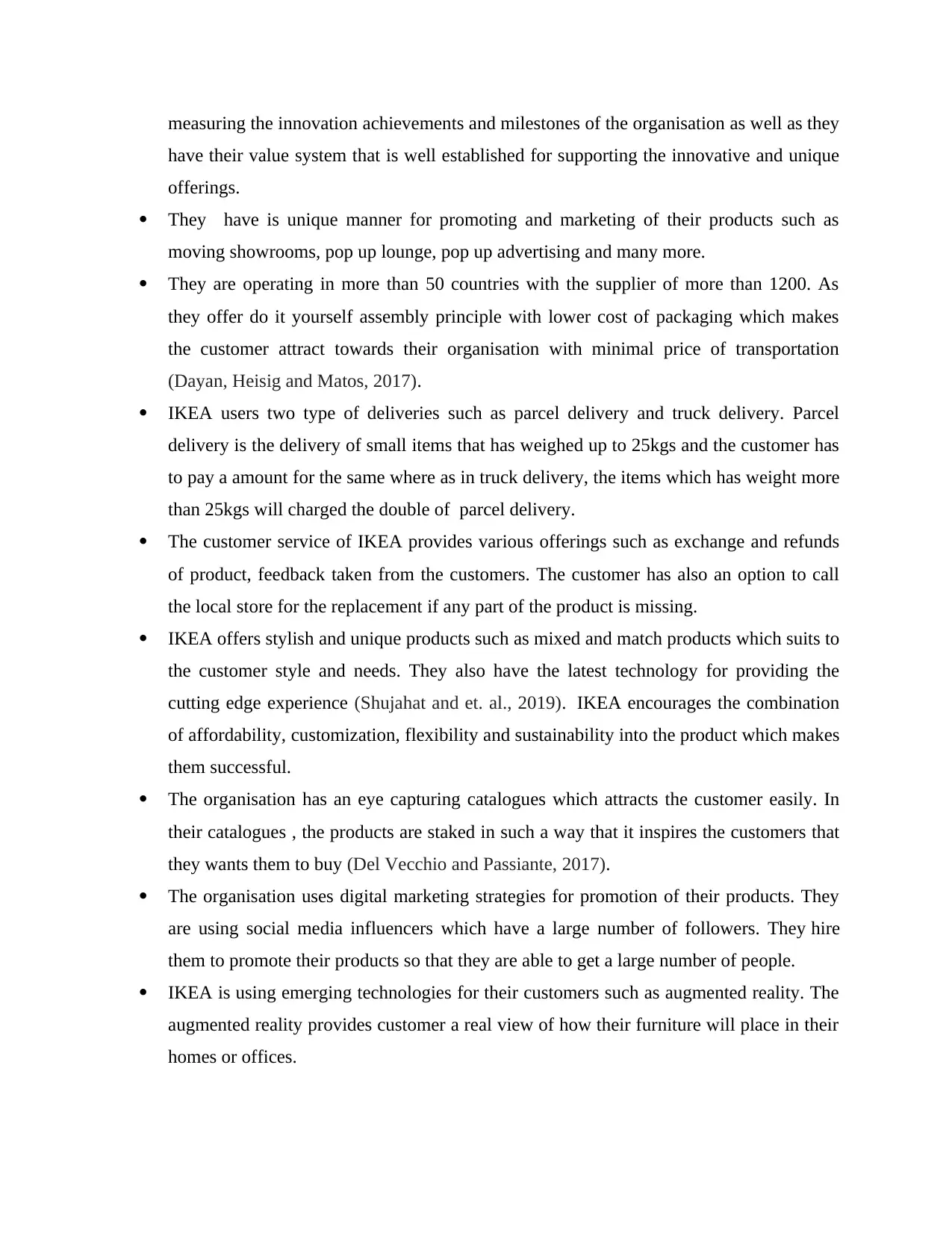
measuring the innovation achievements and milestones of the organisation as well as they
have their value system that is well established for supporting the innovative and unique
offerings.
They have is unique manner for promoting and marketing of their products such as
moving showrooms, pop up lounge, pop up advertising and many more.
They are operating in more than 50 countries with the supplier of more than 1200. As
they offer do it yourself assembly principle with lower cost of packaging which makes
the customer attract towards their organisation with minimal price of transportation
(Dayan, Heisig and Matos, 2017).
IKEA users two type of deliveries such as parcel delivery and truck delivery. Parcel
delivery is the delivery of small items that has weighed up to 25kgs and the customer has
to pay a amount for the same where as in truck delivery, the items which has weight more
than 25kgs will charged the double of parcel delivery.
The customer service of IKEA provides various offerings such as exchange and refunds
of product, feedback taken from the customers. The customer has also an option to call
the local store for the replacement if any part of the product is missing.
IKEA offers stylish and unique products such as mixed and match products which suits to
the customer style and needs. They also have the latest technology for providing the
cutting edge experience (Shujahat and et. al., 2019). IKEA encourages the combination
of affordability, customization, flexibility and sustainability into the product which makes
them successful.
The organisation has an eye capturing catalogues which attracts the customer easily. In
their catalogues , the products are staked in such a way that it inspires the customers that
they wants them to buy (Del Vecchio and Passiante, 2017).
The organisation uses digital marketing strategies for promotion of their products. They
are using social media influencers which have a large number of followers. They hire
them to promote their products so that they are able to get a large number of people.
IKEA is using emerging technologies for their customers such as augmented reality. The
augmented reality provides customer a real view of how their furniture will place in their
homes or offices.
have their value system that is well established for supporting the innovative and unique
offerings.
They have is unique manner for promoting and marketing of their products such as
moving showrooms, pop up lounge, pop up advertising and many more.
They are operating in more than 50 countries with the supplier of more than 1200. As
they offer do it yourself assembly principle with lower cost of packaging which makes
the customer attract towards their organisation with minimal price of transportation
(Dayan, Heisig and Matos, 2017).
IKEA users two type of deliveries such as parcel delivery and truck delivery. Parcel
delivery is the delivery of small items that has weighed up to 25kgs and the customer has
to pay a amount for the same where as in truck delivery, the items which has weight more
than 25kgs will charged the double of parcel delivery.
The customer service of IKEA provides various offerings such as exchange and refunds
of product, feedback taken from the customers. The customer has also an option to call
the local store for the replacement if any part of the product is missing.
IKEA offers stylish and unique products such as mixed and match products which suits to
the customer style and needs. They also have the latest technology for providing the
cutting edge experience (Shujahat and et. al., 2019). IKEA encourages the combination
of affordability, customization, flexibility and sustainability into the product which makes
them successful.
The organisation has an eye capturing catalogues which attracts the customer easily. In
their catalogues , the products are staked in such a way that it inspires the customers that
they wants them to buy (Del Vecchio and Passiante, 2017).
The organisation uses digital marketing strategies for promotion of their products. They
are using social media influencers which have a large number of followers. They hire
them to promote their products so that they are able to get a large number of people.
IKEA is using emerging technologies for their customers such as augmented reality. The
augmented reality provides customer a real view of how their furniture will place in their
homes or offices.
Paraphrase This Document
Need a fresh take? Get an instant paraphrase of this document with our AI Paraphraser
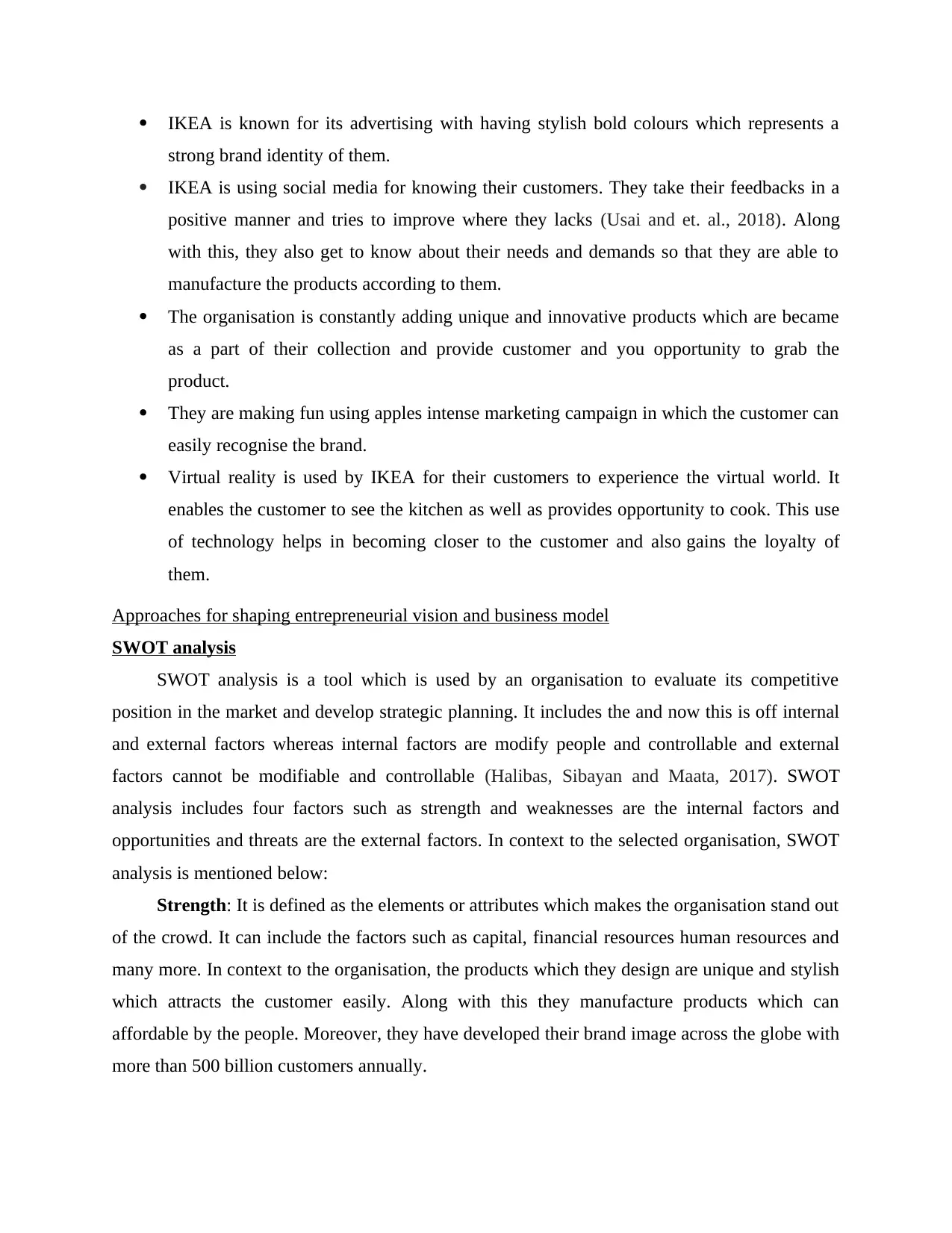
IKEA is known for its advertising with having stylish bold colours which represents a
strong brand identity of them.
IKEA is using social media for knowing their customers. They take their feedbacks in a
positive manner and tries to improve where they lacks (Usai and et. al., 2018). Along
with this, they also get to know about their needs and demands so that they are able to
manufacture the products according to them.
The organisation is constantly adding unique and innovative products which are became
as a part of their collection and provide customer and you opportunity to grab the
product.
They are making fun using apples intense marketing campaign in which the customer can
easily recognise the brand.
Virtual reality is used by IKEA for their customers to experience the virtual world. It
enables the customer to see the kitchen as well as provides opportunity to cook. This use
of technology helps in becoming closer to the customer and also gains the loyalty of
them.
Approaches for shaping entrepreneurial vision and business model
SWOT analysis
SWOT analysis is a tool which is used by an organisation to evaluate its competitive
position in the market and develop strategic planning. It includes the and now this is off internal
and external factors whereas internal factors are modify people and controllable and external
factors cannot be modifiable and controllable (Halibas, Sibayan and Maata, 2017). SWOT
analysis includes four factors such as strength and weaknesses are the internal factors and
opportunities and threats are the external factors. In context to the selected organisation, SWOT
analysis is mentioned below:
Strength: It is defined as the elements or attributes which makes the organisation stand out
of the crowd. It can include the factors such as capital, financial resources human resources and
many more. In context to the organisation, the products which they design are unique and stylish
which attracts the customer easily. Along with this they manufacture products which can
affordable by the people. Moreover, they have developed their brand image across the globe with
more than 500 billion customers annually.
strong brand identity of them.
IKEA is using social media for knowing their customers. They take their feedbacks in a
positive manner and tries to improve where they lacks (Usai and et. al., 2018). Along
with this, they also get to know about their needs and demands so that they are able to
manufacture the products according to them.
The organisation is constantly adding unique and innovative products which are became
as a part of their collection and provide customer and you opportunity to grab the
product.
They are making fun using apples intense marketing campaign in which the customer can
easily recognise the brand.
Virtual reality is used by IKEA for their customers to experience the virtual world. It
enables the customer to see the kitchen as well as provides opportunity to cook. This use
of technology helps in becoming closer to the customer and also gains the loyalty of
them.
Approaches for shaping entrepreneurial vision and business model
SWOT analysis
SWOT analysis is a tool which is used by an organisation to evaluate its competitive
position in the market and develop strategic planning. It includes the and now this is off internal
and external factors whereas internal factors are modify people and controllable and external
factors cannot be modifiable and controllable (Halibas, Sibayan and Maata, 2017). SWOT
analysis includes four factors such as strength and weaknesses are the internal factors and
opportunities and threats are the external factors. In context to the selected organisation, SWOT
analysis is mentioned below:
Strength: It is defined as the elements or attributes which makes the organisation stand out
of the crowd. It can include the factors such as capital, financial resources human resources and
many more. In context to the organisation, the products which they design are unique and stylish
which attracts the customer easily. Along with this they manufacture products which can
affordable by the people. Moreover, they have developed their brand image across the globe with
more than 500 billion customers annually.
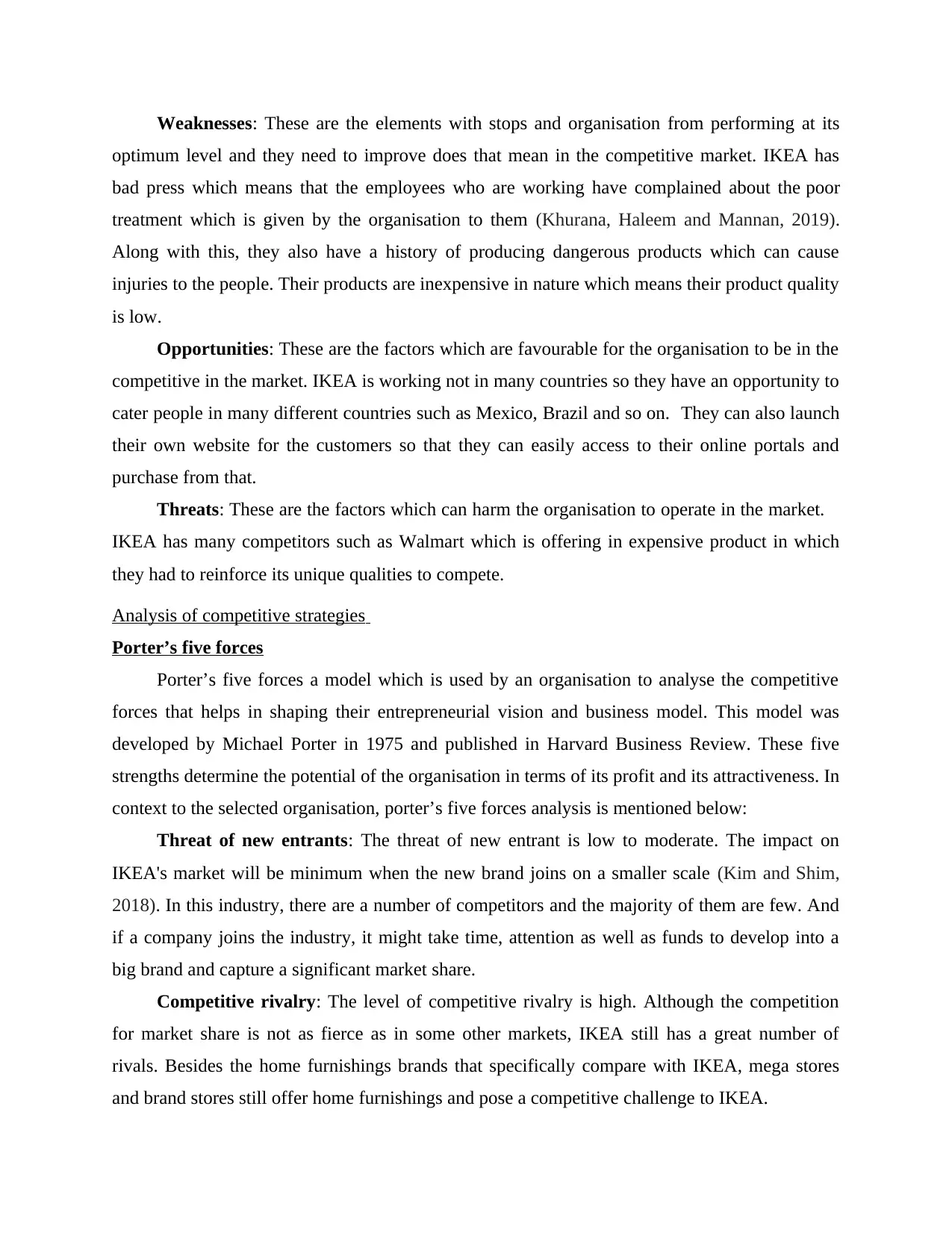
Weaknesses: These are the elements with stops and organisation from performing at its
optimum level and they need to improve does that mean in the competitive market. IKEA has
bad press which means that the employees who are working have complained about the poor
treatment which is given by the organisation to them (Khurana, Haleem and Mannan, 2019).
Along with this, they also have a history of producing dangerous products which can cause
injuries to the people. Their products are inexpensive in nature which means their product quality
is low.
Opportunities: These are the factors which are favourable for the organisation to be in the
competitive in the market. IKEA is working not in many countries so they have an opportunity to
cater people in many different countries such as Mexico, Brazil and so on. They can also launch
their own website for the customers so that they can easily access to their online portals and
purchase from that.
Threats: These are the factors which can harm the organisation to operate in the market.
IKEA has many competitors such as Walmart which is offering in expensive product in which
they had to reinforce its unique qualities to compete.
Analysis of competitive strategies
Porter’s five forces
Porter’s five forces a model which is used by an organisation to analyse the competitive
forces that helps in shaping their entrepreneurial vision and business model. This model was
developed by Michael Porter in 1975 and published in Harvard Business Review. These five
strengths determine the potential of the organisation in terms of its profit and its attractiveness. In
context to the selected organisation, porter’s five forces analysis is mentioned below:
Threat of new entrants: The threat of new entrant is low to moderate. The impact on
IKEA's market will be minimum when the new brand joins on a smaller scale (Kim and Shim,
2018). In this industry, there are a number of competitors and the majority of them are few. And
if a company joins the industry, it might take time, attention as well as funds to develop into a
big brand and capture a significant market share.
Competitive rivalry: The level of competitive rivalry is high. Although the competition
for market share is not as fierce as in some other markets, IKEA still has a great number of
rivals. Besides the home furnishings brands that specifically compare with IKEA, mega stores
and brand stores still offer home furnishings and pose a competitive challenge to IKEA.
optimum level and they need to improve does that mean in the competitive market. IKEA has
bad press which means that the employees who are working have complained about the poor
treatment which is given by the organisation to them (Khurana, Haleem and Mannan, 2019).
Along with this, they also have a history of producing dangerous products which can cause
injuries to the people. Their products are inexpensive in nature which means their product quality
is low.
Opportunities: These are the factors which are favourable for the organisation to be in the
competitive in the market. IKEA is working not in many countries so they have an opportunity to
cater people in many different countries such as Mexico, Brazil and so on. They can also launch
their own website for the customers so that they can easily access to their online portals and
purchase from that.
Threats: These are the factors which can harm the organisation to operate in the market.
IKEA has many competitors such as Walmart which is offering in expensive product in which
they had to reinforce its unique qualities to compete.
Analysis of competitive strategies
Porter’s five forces
Porter’s five forces a model which is used by an organisation to analyse the competitive
forces that helps in shaping their entrepreneurial vision and business model. This model was
developed by Michael Porter in 1975 and published in Harvard Business Review. These five
strengths determine the potential of the organisation in terms of its profit and its attractiveness. In
context to the selected organisation, porter’s five forces analysis is mentioned below:
Threat of new entrants: The threat of new entrant is low to moderate. The impact on
IKEA's market will be minimum when the new brand joins on a smaller scale (Kim and Shim,
2018). In this industry, there are a number of competitors and the majority of them are few. And
if a company joins the industry, it might take time, attention as well as funds to develop into a
big brand and capture a significant market share.
Competitive rivalry: The level of competitive rivalry is high. Although the competition
for market share is not as fierce as in some other markets, IKEA still has a great number of
rivals. Besides the home furnishings brands that specifically compare with IKEA, mega stores
and brand stores still offer home furnishings and pose a competitive challenge to IKEA.
⊘ This is a preview!⊘
Do you want full access?
Subscribe today to unlock all pages.

Trusted by 1+ million students worldwide
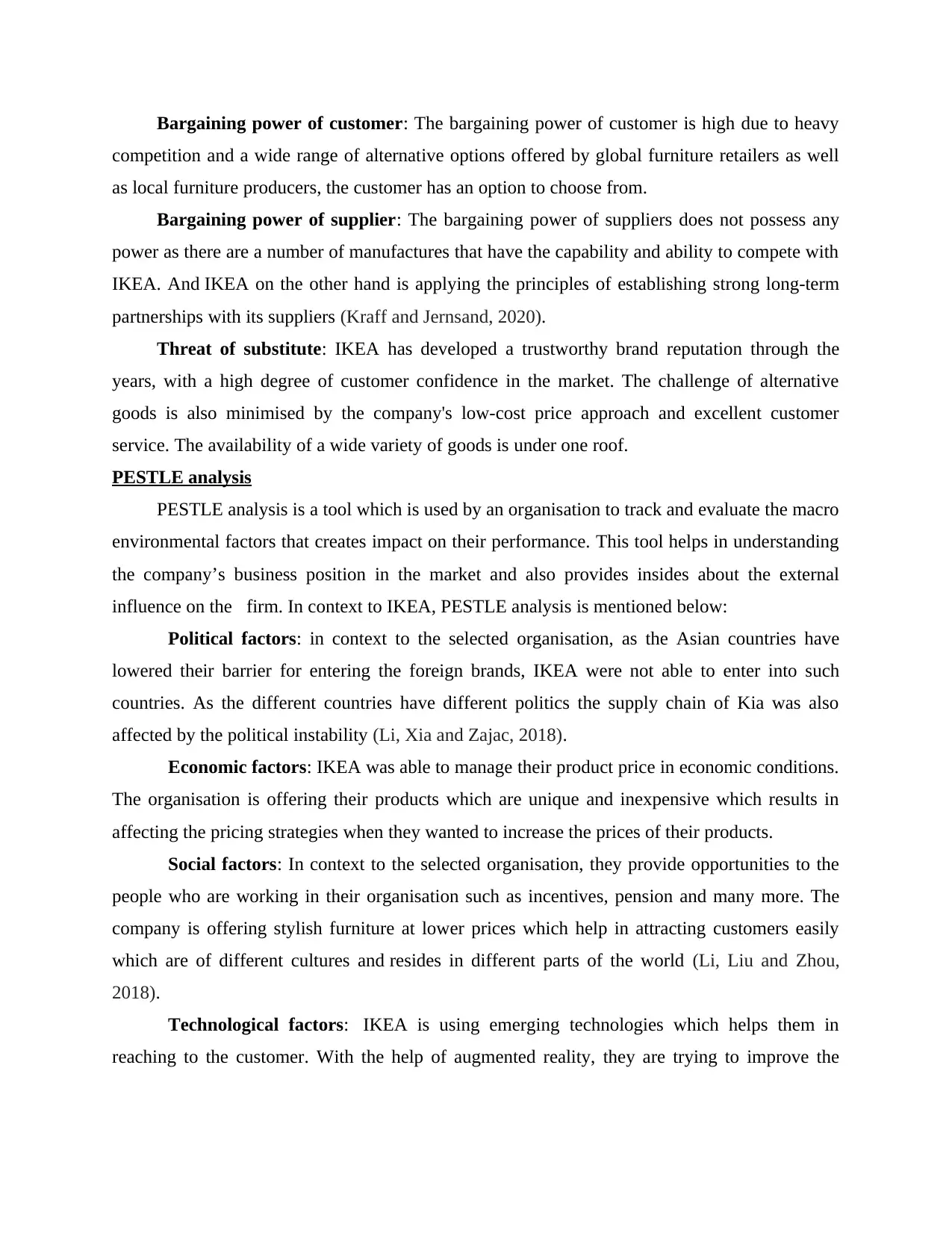
Bargaining power of customer: The bargaining power of customer is high due to heavy
competition and a wide range of alternative options offered by global furniture retailers as well
as local furniture producers, the customer has an option to choose from.
Bargaining power of supplier: The bargaining power of suppliers does not possess any
power as there are a number of manufactures that have the capability and ability to compete with
IKEA. And IKEA on the other hand is applying the principles of establishing strong long-term
partnerships with its suppliers (Kraff and Jernsand, 2020).
Threat of substitute: IKEA has developed a trustworthy brand reputation through the
years, with a high degree of customer confidence in the market. The challenge of alternative
goods is also minimised by the company's low-cost price approach and excellent customer
service. The availability of a wide variety of goods is under one roof.
PESTLE analysis
PESTLE analysis is a tool which is used by an organisation to track and evaluate the macro
environmental factors that creates impact on their performance. This tool helps in understanding
the company’s business position in the market and also provides insides about the external
influence on the firm. In context to IKEA, PESTLE analysis is mentioned below:
Political factors: in context to the selected organisation, as the Asian countries have
lowered their barrier for entering the foreign brands, IKEA were not able to enter into such
countries. As the different countries have different politics the supply chain of Kia was also
affected by the political instability (Li, Xia and Zajac, 2018).
Economic factors: IKEA was able to manage their product price in economic conditions.
The organisation is offering their products which are unique and inexpensive which results in
affecting the pricing strategies when they wanted to increase the prices of their products.
Social factors: In context to the selected organisation, they provide opportunities to the
people who are working in their organisation such as incentives, pension and many more. The
company is offering stylish furniture at lower prices which help in attracting customers easily
which are of different cultures and resides in different parts of the world (Li, Liu and Zhou,
2018).
Technological factors: IKEA is using emerging technologies which helps them in
reaching to the customer. With the help of augmented reality, they are trying to improve the
competition and a wide range of alternative options offered by global furniture retailers as well
as local furniture producers, the customer has an option to choose from.
Bargaining power of supplier: The bargaining power of suppliers does not possess any
power as there are a number of manufactures that have the capability and ability to compete with
IKEA. And IKEA on the other hand is applying the principles of establishing strong long-term
partnerships with its suppliers (Kraff and Jernsand, 2020).
Threat of substitute: IKEA has developed a trustworthy brand reputation through the
years, with a high degree of customer confidence in the market. The challenge of alternative
goods is also minimised by the company's low-cost price approach and excellent customer
service. The availability of a wide variety of goods is under one roof.
PESTLE analysis
PESTLE analysis is a tool which is used by an organisation to track and evaluate the macro
environmental factors that creates impact on their performance. This tool helps in understanding
the company’s business position in the market and also provides insides about the external
influence on the firm. In context to IKEA, PESTLE analysis is mentioned below:
Political factors: in context to the selected organisation, as the Asian countries have
lowered their barrier for entering the foreign brands, IKEA were not able to enter into such
countries. As the different countries have different politics the supply chain of Kia was also
affected by the political instability (Li, Xia and Zajac, 2018).
Economic factors: IKEA was able to manage their product price in economic conditions.
The organisation is offering their products which are unique and inexpensive which results in
affecting the pricing strategies when they wanted to increase the prices of their products.
Social factors: In context to the selected organisation, they provide opportunities to the
people who are working in their organisation such as incentives, pension and many more. The
company is offering stylish furniture at lower prices which help in attracting customers easily
which are of different cultures and resides in different parts of the world (Li, Liu and Zhou,
2018).
Technological factors: IKEA is using emerging technologies which helps them in
reaching to the customer. With the help of augmented reality, they are trying to improve the
Paraphrase This Document
Need a fresh take? Get an instant paraphrase of this document with our AI Paraphraser
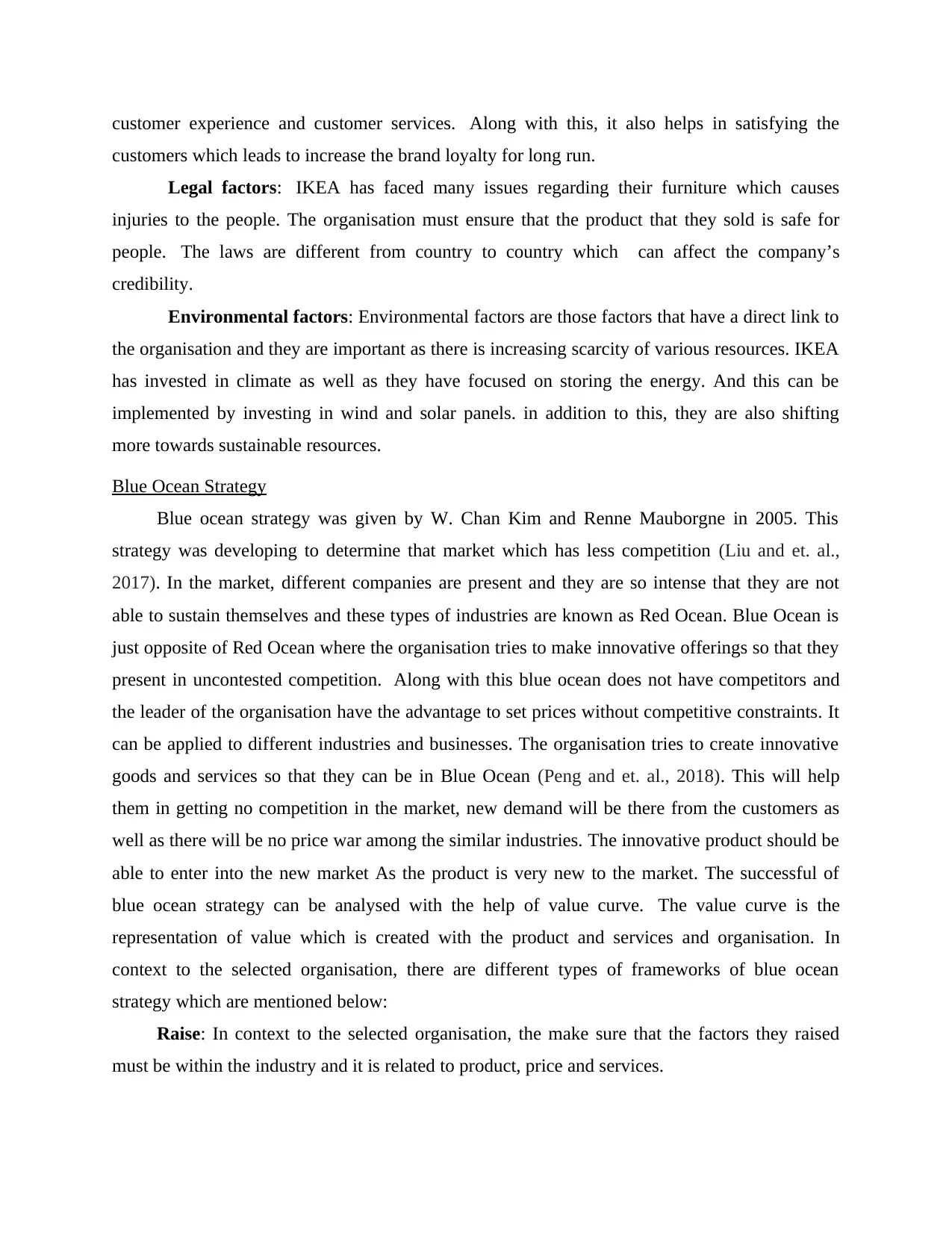
customer experience and customer services. Along with this, it also helps in satisfying the
customers which leads to increase the brand loyalty for long run.
Legal factors: IKEA has faced many issues regarding their furniture which causes
injuries to the people. The organisation must ensure that the product that they sold is safe for
people. The laws are different from country to country which can affect the company’s
credibility.
Environmental factors: Environmental factors are those factors that have a direct link to
the organisation and they are important as there is increasing scarcity of various resources. IKEA
has invested in climate as well as they have focused on storing the energy. And this can be
implemented by investing in wind and solar panels. in addition to this, they are also shifting
more towards sustainable resources.
Blue Ocean Strategy
Blue ocean strategy was given by W. Chan Kim and Renne Mauborgne in 2005. This
strategy was developing to determine that market which has less competition (Liu and et. al.,
2017). In the market, different companies are present and they are so intense that they are not
able to sustain themselves and these types of industries are known as Red Ocean. Blue Ocean is
just opposite of Red Ocean where the organisation tries to make innovative offerings so that they
present in uncontested competition. Along with this blue ocean does not have competitors and
the leader of the organisation have the advantage to set prices without competitive constraints. It
can be applied to different industries and businesses. The organisation tries to create innovative
goods and services so that they can be in Blue Ocean (Peng and et. al., 2018). This will help
them in getting no competition in the market, new demand will be there from the customers as
well as there will be no price war among the similar industries. The innovative product should be
able to enter into the new market As the product is very new to the market. The successful of
blue ocean strategy can be analysed with the help of value curve. The value curve is the
representation of value which is created with the product and services and organisation. In
context to the selected organisation, there are different types of frameworks of blue ocean
strategy which are mentioned below:
Raise: In context to the selected organisation, the make sure that the factors they raised
must be within the industry and it is related to product, price and services.
customers which leads to increase the brand loyalty for long run.
Legal factors: IKEA has faced many issues regarding their furniture which causes
injuries to the people. The organisation must ensure that the product that they sold is safe for
people. The laws are different from country to country which can affect the company’s
credibility.
Environmental factors: Environmental factors are those factors that have a direct link to
the organisation and they are important as there is increasing scarcity of various resources. IKEA
has invested in climate as well as they have focused on storing the energy. And this can be
implemented by investing in wind and solar panels. in addition to this, they are also shifting
more towards sustainable resources.
Blue Ocean Strategy
Blue ocean strategy was given by W. Chan Kim and Renne Mauborgne in 2005. This
strategy was developing to determine that market which has less competition (Liu and et. al.,
2017). In the market, different companies are present and they are so intense that they are not
able to sustain themselves and these types of industries are known as Red Ocean. Blue Ocean is
just opposite of Red Ocean where the organisation tries to make innovative offerings so that they
present in uncontested competition. Along with this blue ocean does not have competitors and
the leader of the organisation have the advantage to set prices without competitive constraints. It
can be applied to different industries and businesses. The organisation tries to create innovative
goods and services so that they can be in Blue Ocean (Peng and et. al., 2018). This will help
them in getting no competition in the market, new demand will be there from the customers as
well as there will be no price war among the similar industries. The innovative product should be
able to enter into the new market As the product is very new to the market. The successful of
blue ocean strategy can be analysed with the help of value curve. The value curve is the
representation of value which is created with the product and services and organisation. In
context to the selected organisation, there are different types of frameworks of blue ocean
strategy which are mentioned below:
Raise: In context to the selected organisation, the make sure that the factors they raised
must be within the industry and it is related to product, price and services.
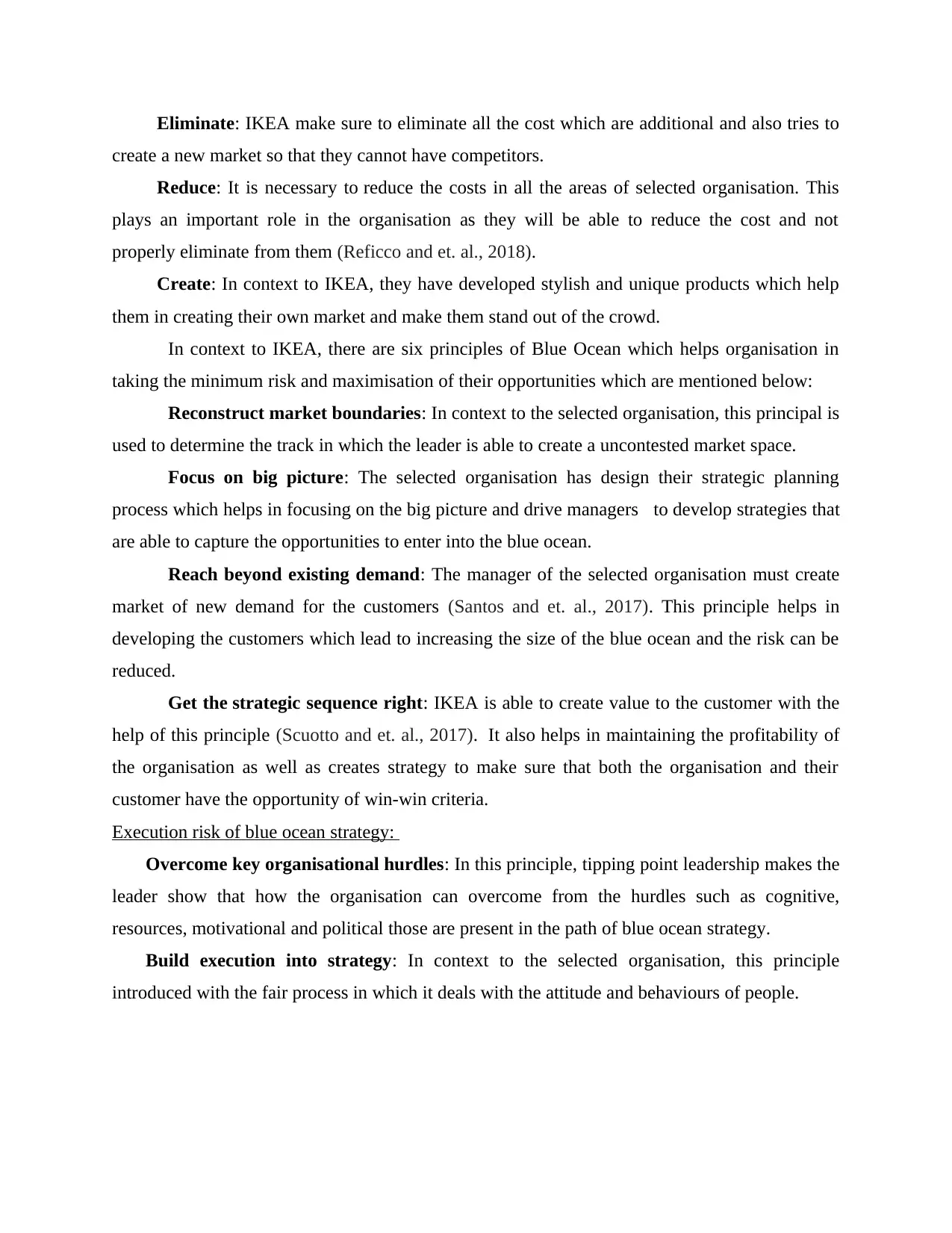
Eliminate: IKEA make sure to eliminate all the cost which are additional and also tries to
create a new market so that they cannot have competitors.
Reduce: It is necessary to reduce the costs in all the areas of selected organisation. This
plays an important role in the organisation as they will be able to reduce the cost and not
properly eliminate from them (Reficco and et. al., 2018).
Create: In context to IKEA, they have developed stylish and unique products which help
them in creating their own market and make them stand out of the crowd.
In context to IKEA, there are six principles of Blue Ocean which helps organisation in
taking the minimum risk and maximisation of their opportunities which are mentioned below:
Reconstruct market boundaries: In context to the selected organisation, this principal is
used to determine the track in which the leader is able to create a uncontested market space.
Focus on big picture: The selected organisation has design their strategic planning
process which helps in focusing on the big picture and drive managers to develop strategies that
are able to capture the opportunities to enter into the blue ocean.
Reach beyond existing demand: The manager of the selected organisation must create
market of new demand for the customers (Santos and et. al., 2017). This principle helps in
developing the customers which lead to increasing the size of the blue ocean and the risk can be
reduced.
Get the strategic sequence right: IKEA is able to create value to the customer with the
help of this principle (Scuotto and et. al., 2017). It also helps in maintaining the profitability of
the organisation as well as creates strategy to make sure that both the organisation and their
customer have the opportunity of win-win criteria.
Execution risk of blue ocean strategy:
Overcome key organisational hurdles: In this principle, tipping point leadership makes the
leader show that how the organisation can overcome from the hurdles such as cognitive,
resources, motivational and political those are present in the path of blue ocean strategy.
Build execution into strategy: In context to the selected organisation, this principle
introduced with the fair process in which it deals with the attitude and behaviours of people.
create a new market so that they cannot have competitors.
Reduce: It is necessary to reduce the costs in all the areas of selected organisation. This
plays an important role in the organisation as they will be able to reduce the cost and not
properly eliminate from them (Reficco and et. al., 2018).
Create: In context to IKEA, they have developed stylish and unique products which help
them in creating their own market and make them stand out of the crowd.
In context to IKEA, there are six principles of Blue Ocean which helps organisation in
taking the minimum risk and maximisation of their opportunities which are mentioned below:
Reconstruct market boundaries: In context to the selected organisation, this principal is
used to determine the track in which the leader is able to create a uncontested market space.
Focus on big picture: The selected organisation has design their strategic planning
process which helps in focusing on the big picture and drive managers to develop strategies that
are able to capture the opportunities to enter into the blue ocean.
Reach beyond existing demand: The manager of the selected organisation must create
market of new demand for the customers (Santos and et. al., 2017). This principle helps in
developing the customers which lead to increasing the size of the blue ocean and the risk can be
reduced.
Get the strategic sequence right: IKEA is able to create value to the customer with the
help of this principle (Scuotto and et. al., 2017). It also helps in maintaining the profitability of
the organisation as well as creates strategy to make sure that both the organisation and their
customer have the opportunity of win-win criteria.
Execution risk of blue ocean strategy:
Overcome key organisational hurdles: In this principle, tipping point leadership makes the
leader show that how the organisation can overcome from the hurdles such as cognitive,
resources, motivational and political those are present in the path of blue ocean strategy.
Build execution into strategy: In context to the selected organisation, this principle
introduced with the fair process in which it deals with the attitude and behaviours of people.
⊘ This is a preview!⊘
Do you want full access?
Subscribe today to unlock all pages.

Trusted by 1+ million students worldwide
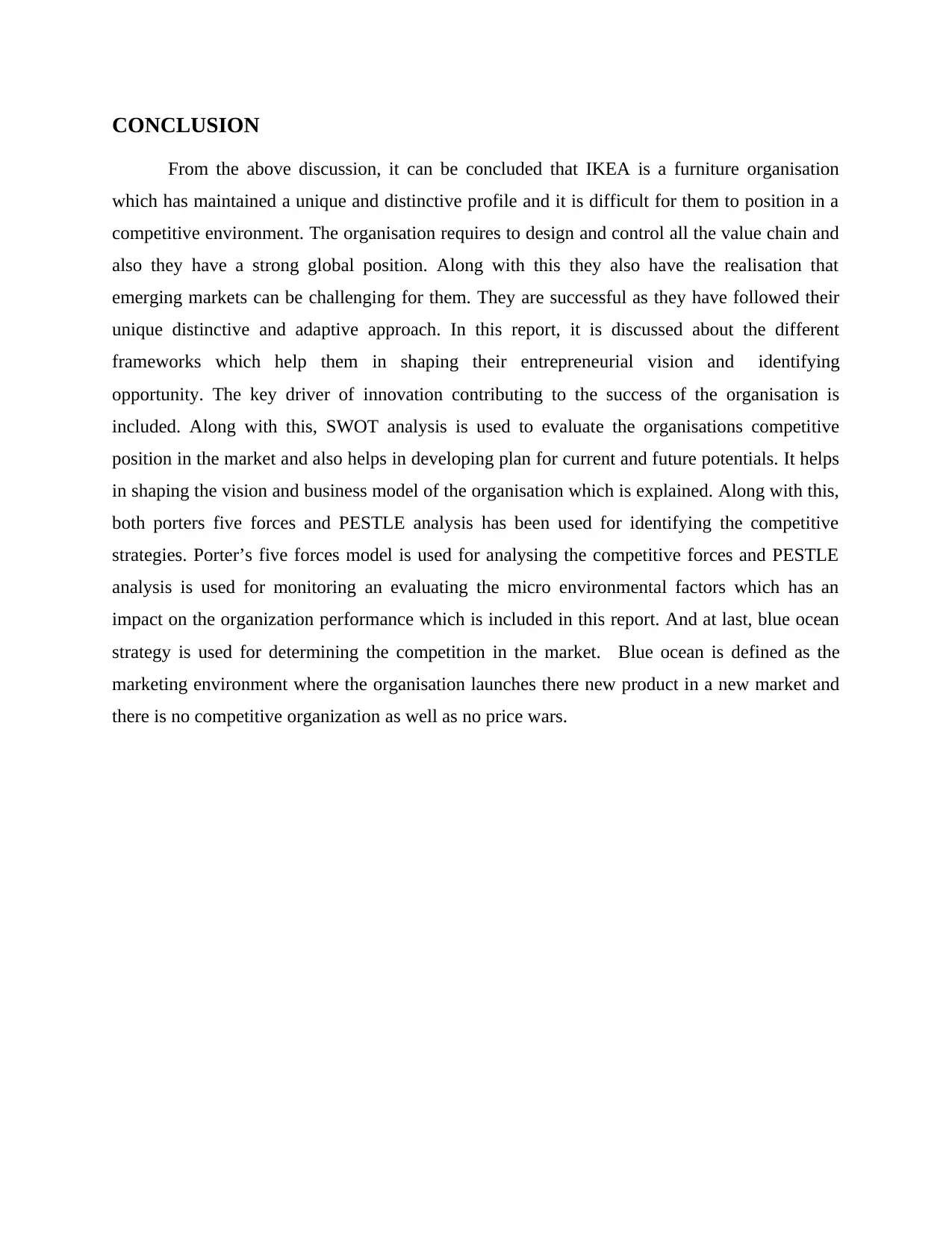
CONCLUSION
From the above discussion, it can be concluded that IKEA is a furniture organisation
which has maintained a unique and distinctive profile and it is difficult for them to position in a
competitive environment. The organisation requires to design and control all the value chain and
also they have a strong global position. Along with this they also have the realisation that
emerging markets can be challenging for them. They are successful as they have followed their
unique distinctive and adaptive approach. In this report, it is discussed about the different
frameworks which help them in shaping their entrepreneurial vision and identifying
opportunity. The key driver of innovation contributing to the success of the organisation is
included. Along with this, SWOT analysis is used to evaluate the organisations competitive
position in the market and also helps in developing plan for current and future potentials. It helps
in shaping the vision and business model of the organisation which is explained. Along with this,
both porters five forces and PESTLE analysis has been used for identifying the competitive
strategies. Porter’s five forces model is used for analysing the competitive forces and PESTLE
analysis is used for monitoring an evaluating the micro environmental factors which has an
impact on the organization performance which is included in this report. And at last, blue ocean
strategy is used for determining the competition in the market. Blue ocean is defined as the
marketing environment where the organisation launches there new product in a new market and
there is no competitive organization as well as no price wars.
From the above discussion, it can be concluded that IKEA is a furniture organisation
which has maintained a unique and distinctive profile and it is difficult for them to position in a
competitive environment. The organisation requires to design and control all the value chain and
also they have a strong global position. Along with this they also have the realisation that
emerging markets can be challenging for them. They are successful as they have followed their
unique distinctive and adaptive approach. In this report, it is discussed about the different
frameworks which help them in shaping their entrepreneurial vision and identifying
opportunity. The key driver of innovation contributing to the success of the organisation is
included. Along with this, SWOT analysis is used to evaluate the organisations competitive
position in the market and also helps in developing plan for current and future potentials. It helps
in shaping the vision and business model of the organisation which is explained. Along with this,
both porters five forces and PESTLE analysis has been used for identifying the competitive
strategies. Porter’s five forces model is used for analysing the competitive forces and PESTLE
analysis is used for monitoring an evaluating the micro environmental factors which has an
impact on the organization performance which is included in this report. And at last, blue ocean
strategy is used for determining the competition in the market. Blue ocean is defined as the
marketing environment where the organisation launches there new product in a new market and
there is no competitive organization as well as no price wars.
Paraphrase This Document
Need a fresh take? Get an instant paraphrase of this document with our AI Paraphraser
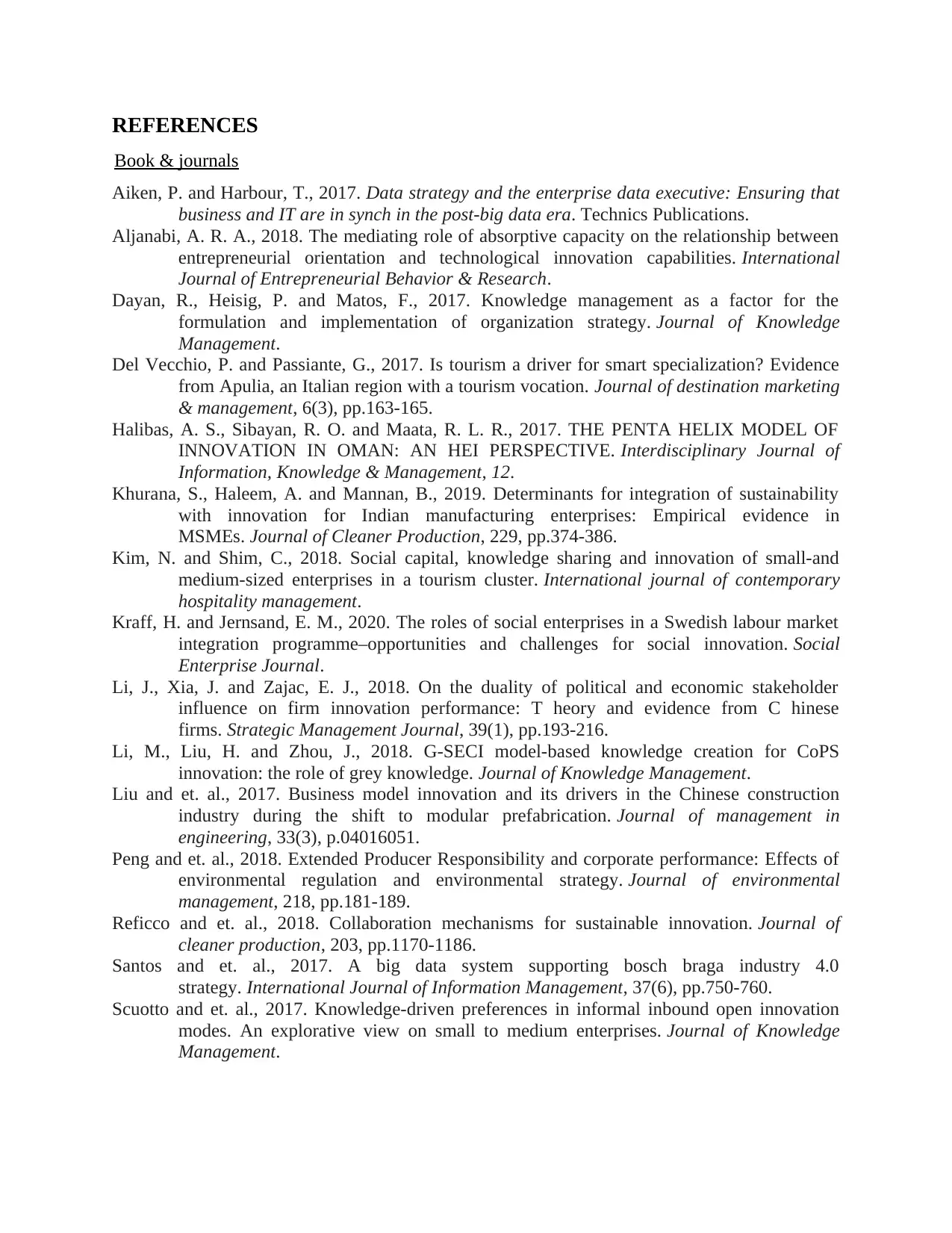
REFERENCES
Book & journals
Aiken, P. and Harbour, T., 2017. Data strategy and the enterprise data executive: Ensuring that
business and IT are in synch in the post-big data era. Technics Publications.
Aljanabi, A. R. A., 2018. The mediating role of absorptive capacity on the relationship between
entrepreneurial orientation and technological innovation capabilities. International
Journal of Entrepreneurial Behavior & Research.
Dayan, R., Heisig, P. and Matos, F., 2017. Knowledge management as a factor for the
formulation and implementation of organization strategy. Journal of Knowledge
Management.
Del Vecchio, P. and Passiante, G., 2017. Is tourism a driver for smart specialization? Evidence
from Apulia, an Italian region with a tourism vocation. Journal of destination marketing
& management, 6(3), pp.163-165.
Halibas, A. S., Sibayan, R. O. and Maata, R. L. R., 2017. THE PENTA HELIX MODEL OF
INNOVATION IN OMAN: AN HEI PERSPECTIVE. Interdisciplinary Journal of
Information, Knowledge & Management, 12.
Khurana, S., Haleem, A. and Mannan, B., 2019. Determinants for integration of sustainability
with innovation for Indian manufacturing enterprises: Empirical evidence in
MSMEs. Journal of Cleaner Production, 229, pp.374-386.
Kim, N. and Shim, C., 2018. Social capital, knowledge sharing and innovation of small-and
medium-sized enterprises in a tourism cluster. International journal of contemporary
hospitality management.
Kraff, H. and Jernsand, E. M., 2020. The roles of social enterprises in a Swedish labour market
integration programme–opportunities and challenges for social innovation. Social
Enterprise Journal.
Li, J., Xia, J. and Zajac, E. J., 2018. On the duality of political and economic stakeholder
influence on firm innovation performance: T heory and evidence from C hinese
firms. Strategic Management Journal, 39(1), pp.193-216.
Li, M., Liu, H. and Zhou, J., 2018. G-SECI model-based knowledge creation for CoPS
innovation: the role of grey knowledge. Journal of Knowledge Management.
Liu and et. al., 2017. Business model innovation and its drivers in the Chinese construction
industry during the shift to modular prefabrication. Journal of management in
engineering, 33(3), p.04016051.
Peng and et. al., 2018. Extended Producer Responsibility and corporate performance: Effects of
environmental regulation and environmental strategy. Journal of environmental
management, 218, pp.181-189.
Reficco and et. al., 2018. Collaboration mechanisms for sustainable innovation. Journal of
cleaner production, 203, pp.1170-1186.
Santos and et. al., 2017. A big data system supporting bosch braga industry 4.0
strategy. International Journal of Information Management, 37(6), pp.750-760.
Scuotto and et. al., 2017. Knowledge-driven preferences in informal inbound open innovation
modes. An explorative view on small to medium enterprises. Journal of Knowledge
Management.
Book & journals
Aiken, P. and Harbour, T., 2017. Data strategy and the enterprise data executive: Ensuring that
business and IT are in synch in the post-big data era. Technics Publications.
Aljanabi, A. R. A., 2018. The mediating role of absorptive capacity on the relationship between
entrepreneurial orientation and technological innovation capabilities. International
Journal of Entrepreneurial Behavior & Research.
Dayan, R., Heisig, P. and Matos, F., 2017. Knowledge management as a factor for the
formulation and implementation of organization strategy. Journal of Knowledge
Management.
Del Vecchio, P. and Passiante, G., 2017. Is tourism a driver for smart specialization? Evidence
from Apulia, an Italian region with a tourism vocation. Journal of destination marketing
& management, 6(3), pp.163-165.
Halibas, A. S., Sibayan, R. O. and Maata, R. L. R., 2017. THE PENTA HELIX MODEL OF
INNOVATION IN OMAN: AN HEI PERSPECTIVE. Interdisciplinary Journal of
Information, Knowledge & Management, 12.
Khurana, S., Haleem, A. and Mannan, B., 2019. Determinants for integration of sustainability
with innovation for Indian manufacturing enterprises: Empirical evidence in
MSMEs. Journal of Cleaner Production, 229, pp.374-386.
Kim, N. and Shim, C., 2018. Social capital, knowledge sharing and innovation of small-and
medium-sized enterprises in a tourism cluster. International journal of contemporary
hospitality management.
Kraff, H. and Jernsand, E. M., 2020. The roles of social enterprises in a Swedish labour market
integration programme–opportunities and challenges for social innovation. Social
Enterprise Journal.
Li, J., Xia, J. and Zajac, E. J., 2018. On the duality of political and economic stakeholder
influence on firm innovation performance: T heory and evidence from C hinese
firms. Strategic Management Journal, 39(1), pp.193-216.
Li, M., Liu, H. and Zhou, J., 2018. G-SECI model-based knowledge creation for CoPS
innovation: the role of grey knowledge. Journal of Knowledge Management.
Liu and et. al., 2017. Business model innovation and its drivers in the Chinese construction
industry during the shift to modular prefabrication. Journal of management in
engineering, 33(3), p.04016051.
Peng and et. al., 2018. Extended Producer Responsibility and corporate performance: Effects of
environmental regulation and environmental strategy. Journal of environmental
management, 218, pp.181-189.
Reficco and et. al., 2018. Collaboration mechanisms for sustainable innovation. Journal of
cleaner production, 203, pp.1170-1186.
Santos and et. al., 2017. A big data system supporting bosch braga industry 4.0
strategy. International Journal of Information Management, 37(6), pp.750-760.
Scuotto and et. al., 2017. Knowledge-driven preferences in informal inbound open innovation
modes. An explorative view on small to medium enterprises. Journal of Knowledge
Management.
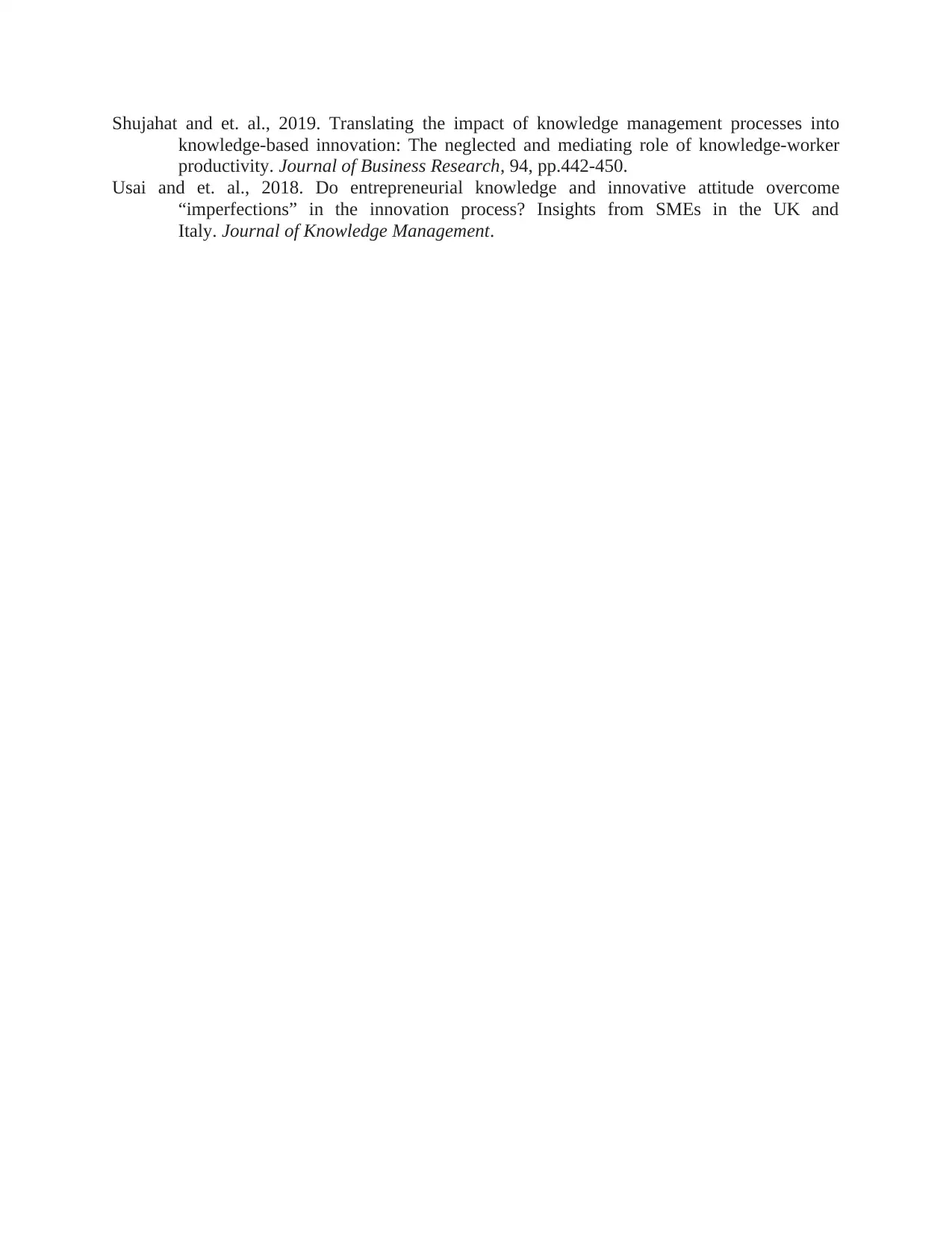
Shujahat and et. al., 2019. Translating the impact of knowledge management processes into
knowledge-based innovation: The neglected and mediating role of knowledge-worker
productivity. Journal of Business Research, 94, pp.442-450.
Usai and et. al., 2018. Do entrepreneurial knowledge and innovative attitude overcome
“imperfections” in the innovation process? Insights from SMEs in the UK and
Italy. Journal of Knowledge Management.
knowledge-based innovation: The neglected and mediating role of knowledge-worker
productivity. Journal of Business Research, 94, pp.442-450.
Usai and et. al., 2018. Do entrepreneurial knowledge and innovative attitude overcome
“imperfections” in the innovation process? Insights from SMEs in the UK and
Italy. Journal of Knowledge Management.
⊘ This is a preview!⊘
Do you want full access?
Subscribe today to unlock all pages.

Trusted by 1+ million students worldwide
1 out of 12
Related Documents
Your All-in-One AI-Powered Toolkit for Academic Success.
+13062052269
info@desklib.com
Available 24*7 on WhatsApp / Email
![[object Object]](/_next/static/media/star-bottom.7253800d.svg)
Unlock your academic potential
Copyright © 2020–2025 A2Z Services. All Rights Reserved. Developed and managed by ZUCOL.





